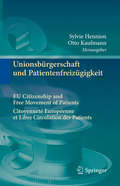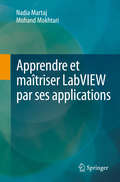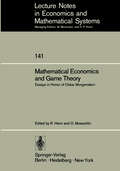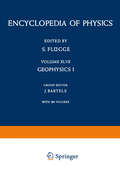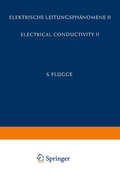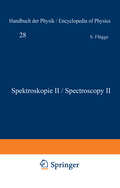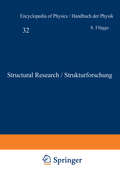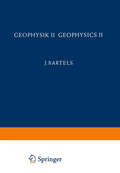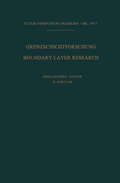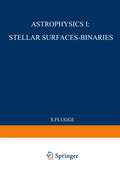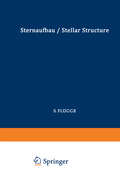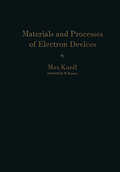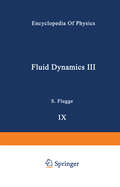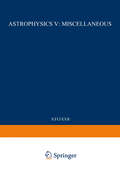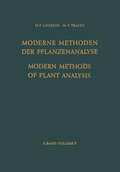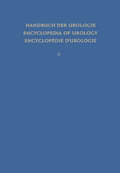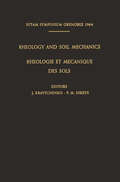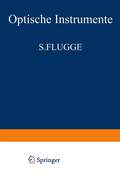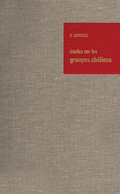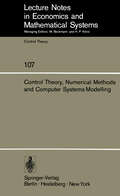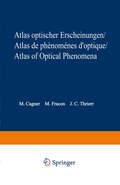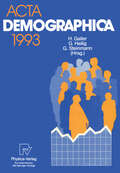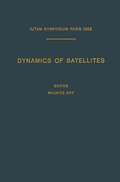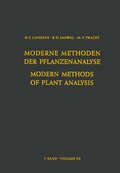- Table View
- List View
Physique des Écoulements Continus (Mathématiques et Applications #74)
by Jean-Paul CaltagironeLa mécanique des fluides est abordée sous deux points de vue, physique et mathématique. Les bases de la mécanique des milieux continus sont d'abord présentées en détail en précisant les hypothèses et approximations qui conduisent aux lois de conservation. Les outils d'analyse des équations générales, étude en ordres de grandeurs, analyse adimensionnelle et similitude, permettent ensuite d'introduire les approximations de fluide parfait d'Euler, de fluides visqueux en régime de Stokes et de la couche limite de Prandtl. Les notions de stabilité des écoulements, de turbulence et les écoulements compressibles sont ensuite présentés. Les écoulements multiphysiques ouvrent des perspectives pour la recherche et le traitement d'applications complexes. In this book, fluid mechanics is addressed from both physical and mathematical perspectives. As a first step, the basic theory of continuum mechanics is detailed, pointing out the different assumptions and approximations that lead to conservation laws. As a second step, scaling studies, dimensional analysis and similitude of the general equations help to introduce the inviscid Euler fluid approximation, the Stokes approximation of viscous flow and Prandtl’s boundary layer approximation. Lastly, the concepts of stability, turbulence and compressible flows are presented. Multiphysics approach of flows will provide readers with deeper insights into basic and applied research on complex processing.
Unionsbürgerschaft und Patientenfreizügigkeit Citoyenneté Européenne et Libre Circulation des Patients EU Citizenship and Free Movement of Patients
by Sylvie Hennion Otto KaufmannDie grenzüberschreitende Mobilität der Patienten wirft zahlreiche Rechts- und Wirtschaftsfragen auf. Es geht um die Vereinbarkeit der finanziellen Auswirkungen der von den Mitgliedstaaten getroffenen Maßnahmen zur Kosteneindämmung mit dem Recht des Unionsbürgers auf Freizügigkeit. Es geht auch um den Zugang zu Leistungen. Die Koordinierungs-Verordnungen und die Richtlinie 2011/24/EU über die Patientenrechte in der grenzüberschreitenden Gesundheitsversorgung, aber auch länderübergreifende Vereinbarungen sind dafür Grundlage. Rechtsnormen zum Datenschutz und zum Berufsgeheimnis, die bei grenzüberschreitender Mobilität auch den Leistungserbringern und Versicherern obliegen, sind ebenfalls zu berücksichtigen.Cross-border patient mobility raises numerous legal and economic issues. The financial impact of cost-containment measures taken by the Member States must be compatible with the right of EU citizens to free movement. Access to benefits and services must also be guaranteed. The coordination regulations and Directive 2011/24/EU on the application of patients’ rights in cross-border healthcare, as well as transnational agreements, serve as the basis for these considerations. Furthermore, the legal norms regarding data protection and professional confidentiality must be taken into account, since in the context of cross-border mobility they also apply to service providers and insurers.La mobilité transfrontalière des patients dans l’Union européenne soulève de nombreuses interrogations économiques et juridiques. Il s’agit de concilier les conséquences financières des mesures prises par les Etats membres pour contenir les coûts des soins de santé avec le droit du citoyen européen de librement circuler dans l’Union européenne et d’accéder à ces prestations et services. Les règlements de coordination des systèmes de sécurité sociale, la directive 2011/24/UE relative à l’application des droits des patients en matière de soins de santé transfrontaliers ainsi que des accords transfrontaliers constituent des réponses à ces enjeux. Mais ces normes suscitent de nombreuses interrogations de mise en œuvre, de conciliation avec les droits des patients tant dans la protection des données personnelles dans le cadre de la télémédecine que dans le respect du secret professionnel.
Apprendre et maîtriser LabVIEW par ses applications
by Nadia Martaj Mohand MokhtariCet ouvrage traite de l’apprentissage du langage LabVIEW à travers ses applications dans des domaines industriels et académiques, qui permettront à l’ingénieur, technicien ou étudiant d’appréhender rapidement et efficacement ce langage. L’ouvrage commence, dans la partie I, par traiter les différents types de données du langage LabVIEW (tableaux, clusters, complexes, chaînes de caractères…), leur manipulation dans des structures d’exécution (boucles While, For, la structure Condition, etc.), le langage textuel MathScript, des scripts Matlab, la boîte de calcul utilisant la syntaxe du langage C ainsi que les nœuds de propriété qui permettent d’obtenir ou définir la propriété d'un VI. Cette étude est menée à travers des applications d’ingénierie.La partie II est consacrée à l’étude de l’outil « Conception de contrôle et simulation » avec lequel nous pouvons simuler des systèmes analogiques ou discrets.La partie III contient différentes applications qui traitent de nombreux thèmes comme la régulation (différentes structures du PID, les commandes RST, LQI, etc.), la logique floue, le traitement de signal (déterministe, aléatoire et filtrage adaptatif, etc.), le traitement des fichiers de mesure, la statistique expérimentale, etc.
Mathematical Economics and Game Theory: Essays in Honor of Oskar Morgenstern (Lecture Notes in Economics and Mathematical Systems #141)
by R. Henn O. MoeschlinElectrical Conductivity II / Elektrische Leitungsphänomene II (Handbuch der Physik Encyclopedia of Physics #4 / 20)
by O. Madelung A. B. Lidiard J. M. Stevels E. DarmoisSpektroskopie II / Spectroscopy II (Handbuch der Physik Encyclopedia of Physics #5 / 28)
by S. FlüggeStructural Research / Strukturforschung (Handbuch der Physik Encyclopedia of Physics #6 / 32)
by Dr. André Guinier Dr. Gérard Eller Dr. J. Bouman Dr. Gérard Fournet Professor Dr. Beeman Professor Dr. Kaesberg Dr. J. Anderegg Dr. M. Webb Professor Dr. Raether Dr. G. Ringo107 In this way the absolute values of the structure factors may be found, not the phases (6. 8). The problem to find these phases is the phase problem. The present article will treat the following topics. At first the description of the ideal crystal will be given in Chap. B. The underlying principles of this description are the concepts of reciprocal lattice, FOURIER synthesis and sym metry. The evaluation of the intensity will then follow in Chap. C and D. Chap. E is concerned with the phase problem and related topics. Though this article treats the analysis of crystal structures, the fundamental concepts for other structures will here be found too. But these topics, and the experimental methods, will l find their place elsewhere . B. Description of the crystalline state. I. Lattice theory. a) The direct lattice. 8. Introduction. In Sect. 3, a description of the ideal crystal was given: The space, occupied by a crystal, is divided into congruent parallelepipeds, each with the same orientation. This parallelepiped is defined by the three basic vectors, a, band c, drawn from an origin 0 (Fig. 2), and is called the primitive cell. This cell is filled with atoms (or ions), and the same configuration of atoms is repeated in space. It has been aptly called a three-dimensional wallpaper, as on a wallpaper the same pattern is repeated again and again.
Geophysik II / Geophysics II (Handbuch der Physik Encyclopedia of Physics #10 / 48)
by Julius Bartels45 downwards because (j on the average increases with height; but this conclusion does not follow from (18.3) when the dependency of Kc upon ~o is taken into consideration. s 2 ERTELl and PRIESTLEY and SWINBANK have shown that the upward eddy flux of sensible heat must be larger than indicated by (18.3), because this formula does not account for the fact that rising eddies are systematically warmer than sinking eddies because of the effect of buoyancy. The reader is referred to the reviews by SUTTON [22], [23] and PRIESTLEY and SHEP PARD [15) for further details concerning eddy-flux of heat and turbulent diffusion. 19. RICHARDSON'S criterion. The right-hand side of (15.10) represents the rate of production of eddy energy. The last term represents energy loss by dissipation; in order that the eddy energy shall be maintained, it is therefore necessary that P div V" - (! V" v" . grad. v > O.
Grenzschichtforschung / Boundary Layer Research: Symposium Freiburg/Br. 26.Bis 29. August 1957 / Symposium Freiburg/Br. August 26–29, 1957 (IUTAM Symposia)
by Heinrich GörtlerAstrophysik I: Sternoberflächen-Doppelsterne / Astrophysics I: Stellar-Surfaces-Binaries (Handbuch der Physik Encyclopedia of Physics #11 / 50)
by S. FlüggeAstrophysik II: Sternaufbau / Astrophysics II: Stellar Structure (Handbuch der Physik Encyclopedia of Physics #11 / 51)
by Marshal H. Wrubel H. C. Arp G. R. Burbidge E. Margaret Burbidge Hans E. Suess Harold C. Urey Lawrence H. Aller P. Ledoux Th. Walraven Armin J. Deutsch E. Schatzman Cecilia Payne-Gaposchkin F. ZwickySects. 12, 13. 89 sequence and that subgiant and fainter stars in globular clusters have ultraviolet excesses. When dealing with stars whose physical properties are imperfectly under stood, such as in globular cluster stars, we cannot rely too heavily on the empiri cal calibration by the kinds of stars used to define Fig. 5, to determine their true, unreddened U-B, B-V curve. But if by a combination of arguments, principally the reddening in the region of the stars we do known about, we can assign a fairly probable unreddened U-B, B-V curve to a group of stars about which we know little, the argument may be turned around. In this case some information may be gained about the energy envelope of the stars by examining the differences between the normal two-color index curves for the unknown group of stars compared to the known. In general there seem to be two possible causes for different stars defining different normal sequences in the U-B, B-V plane. One, the relative energy distribution in the continuum in the U, B and V photometry bands are different. An example of this is the effect of the Balmer depression in supergiants. This, of course, requires deviation from black body radiation curves for one or both groups of stars. This cause seems to be the dominant effect for very blue, hot stars where the depression of the continuum by absorption lines is at a minimum.
Materials and Processes of Electron Devices: Werkstoffe und Verfahren zur Herstellung von Entladungsgeräten / Matériaux et procédés pour la construction d’appareils de décharges électriques / Materiales y procesos de fabricación para elementos electrónicos
by Max KnollThis bookis intended to be of assistance to the physicist or engineer concerned with designing and building electron devices such as high-vacuum transmitter- or amplifier tubes, gas- or vapor-filled rectifiers, thyratrons, X-ray or luminescent tubes, glow or incandescent lamps, Geiger- or ionization counters, vacuum photo cells, photoconductive cells, selenium-, germanium- or silicon rectifiers or trans istors. For this purpose, extensive information is required concerning the compo sition, behavior and handling of materials as well as a thorough knowledge of high-vacuum technique necessary for processing electron devices after their assembly. The text covers the preparation and working of materials used in these devices; the finishing methods for vacuum tubes (especially degassing, pumping and getter procedures); and different production steps of solid state devices. This book contains about 2300 references indicated in the text by the author's name and reference number. At the end of each chapter the references themselves are listed alphabetically by the author's name and with the title sometimes abbreviated. In accordance with the purpose of the book, "first" publications are quoted only when they contain up-to-date-knowledge of the subject in question. Patents are treated as references. The quotation of a patent gives only a hint of the technical details described there. Mentioning, or not mentioning, a patent does not imply a statement concerning its importance or validity or warning against imitation. Expired patents are named in addition to ones still valid.
Fluid Dynamics / Strömungsmechanik (Handbuch der Physik Encyclopedia of Physics #3 / 9)
by C. A. TruesdellSect 2. 317 tinuity surfaces 1. This suggests that a wake pressure Pw be associated with each flow past a bluff body, and that a wake parameter (2. 4) which plays the same role as the cavitation parameter (2. 1), be defined for the flow. This idea has been made the basis of a modified wake theory (ef. Sect. 11) which proves to be in good qu- titative agreement with pressure and drag measurements. It should be emphasized, however, that un h like the cavitation number, the wake parameter is a quantity which is not known a priori, and must be empirically determined in each case. (3) Jet flows. The problem of jet efflux from an orifice is one of the oldest in hydrodynamics and the first to be treated by Fig. 3a. the HELMHOLTZ free streamline theory. Of particular importance for engineering applications is the discharge coefficient Cd' which is defined in terms of the discharge Q per unit time, the pressure P, and the cross-sectional area A of the orifice, by the formula, (2. 5) where e is the fluid density. Two methods of measuring Cd have been most fre quently adopted. In the first the liquid issues from an orifice in a large vessel under the influence of gravity _,-____________ . , (Fig. 3 a), while in the second it 1 L is forced out of a nozzle or pipe under high pressure (Fig. 3 b).
Astrophysics V: Miscellaneous / Astrophysik V: Verschiedenes (Handbuch der Physik Encyclopedia of Physics #11 / 54)
by S. FlüggeModern Methods of Plant Analysis / Moderne Methoden der Pflanzenanalyse (Modern Methods of Plant Analysis Moderne Methoden der Pflanzenanalyse #5)
by K. Biemann N. K. Boardman B. Breyer S. P. Burg W. L. Butler D. J. David P. S. Davis A. E. Dimond A. C. Hildebrandt F. A. Hommes O. Kratky H. F. Linskens H. Moor K. H. Norris I. J. O'Donnell J. V. Possingham H. Prat D. H. Slogteren E. Stahl J. A. Veken J. P. Want E. F. Woods123 phase and hence have no direct bearing on the retention time of solutes. However in gas-solid chromatography, a considerable quantity of the mobile phase may be adsorbed on the surface of the stationary adsorbent which diminishes the column's effective length and ability to retain solutes. In this respect helium has been found to be preferable to most other gases (GREENE and Roy, 1957) because it is adsorbed to the least extent. 3. Packed columns offer a considerable resistance to flow, which may create a pressure differential between inlet and outlet of sufficient magnitude to cause an unfavorable flow rate through a significant length of the column. A reduced inlet/outlet pressure ratio can be obtained by using light molecular weight gases toward which the column packing shows the greatest permeability. The flow rate of the mobile phase is normally adjusted by altering the column inlet pressure, for which purpose commercial pressure regulators of sufficient accuracy are available. Quantitative measurements of the flow rate can be made by a number of methods, including rotameters, orifice meters, soapfilm flow meters and displacement of water. The former two methods are the most con venient but the least accurate; moreover they create a back pressure and are temperature dependent whereas although the moving soap bubble is cumbersome to employ and unusable for continuous readings, it is preferred when the highest accuracy is required.
Physiologie und Pathologische Physiologie / Physiology and Pathological Physiology / Physiologie Normale et Pathologique (Handbuch der Urologie Encyclopedia of Urology Encyclopedie d'Urologie #2)
by B. Fey F. Heni A. Kuntz D. F. McDonald L. Quenu L. G. Wesson C. WilsonRheology and Soil Mechanics / Rhéologie et Mécanique des Sols: Symposium Grenoble, April 1–8, 1964 / Symposium Grenoble, 1Er–8 Avril 1964 (IUTAM Symposia)
by J. Kravtchenko P. M. SirieysFor a long period Soil Mechanics has remained at the semi-empirica stage, and only a few decades ago it has shown a tendency to become a fundamental science. However, this evolution is taking place slowly; in spite of the efforts of numerous research scientists, the very complex rheological laws of soils are still not well known. Even if these laws were elucidated, it would take a long time still to deduce simple rules from them for reliable and convenient use in current practical engineer ing. In the pursuit of these distant aims - and of others more imme diate - fundamental research and applied research are very active, both in Rheology and Soil Mechanics. The complexity of the problems to be solved should incite the laboratory researchers and the engineers to a continuous collaboration. Everyone acknowledges the advantage of these connections although aware of the difficulty of realizing this wish. However, contacts are being made little by little between the repre sentatives of the different branches of Rheology and Soil Mechanics, to the great benefit of science. The bureau of the International Union of Theoretical and Applied Mechanics (IUTAM), aware of the importance of these two associat ed fields of mechanics, considered it possible to accelerate the natural and necessary processus of their interpenetration by organizing in Grenoble, from 1st to 8th April 1964 an International Symposium on Rheology and Soil Mechanics.
Optische Instrumente / Optical Instruments (Handbuch der Physik Encyclopedia of Physics #5 / 29)
by S. FlüggeÉtudes sur les Groupes Abéliens / Studies on Abelian Groups: Colloque sur la Théorie des Groupes abéliens tenu à l’Université de Montpellier en juin 1967
by Bernard CharlesControl Theory, Numerical Methods and Computer Systems Modelling: International Symposium, Rocquencourt, June 17–21, 1974 (Lecture Notes in Economics and Mathematical Systems #107)
by J. L. Lions A. BensoussanAtlas optischer Erscheinungen / Atlas de phénomènes d’optique / Atlas of optical phenomena
by Michel Cagnet M. Francon J.C. ThrierrActa Demographica 1993 (ACTA DEMOGRAPHICA #1993)
by Heinz Galler Gerhard Heilig Gunter SteinmannDie Acta Demographica ist eine offizielle Publikation der Deutschen Gesellschaft für Bevölkerungswissenschaft. Jeder Band umfaßt herausragende Beiträge zur Bevölkerungswissenschaft, die innerhalb der Arbeitskreise "Bevölkerungswissenschaftliche Methoden", "Geschichte der Bevölkerungswissenschaft", "Bevölkerungsökonomie" und "Demographie der Entwicklungsländer" der Deutschen Gesellschaft für Bevölkerungswissenschaft oder an anderer Stelle im deutschen und europäischen Raum entstanden sind. Es werden sowohl empirische wie theoretische Beiträge veröffentlicht, die sich mit fachspezifischen und interdisziplinären Themen beschäftigen.

